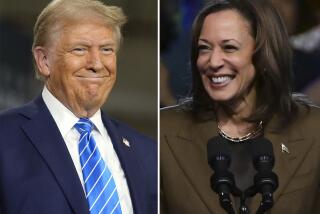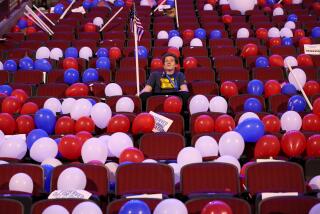Primary election calendar in flux
- Share via
As the jockeying among White House hopefuls intensifies, the skirmishing has also grown among states setting their primary and caucus dates. The result, in both instances, is growing uncertainty about the shape of the 2008 race.
*
Where does the presidential calendar stand?
It’s very much in flux. Iowa was expected to start the balloting Jan. 14, then Nevada, New Hampshire and South Carolina in the three weeks that follow. But Florida may change all that. Ignoring the rules set by the national parties, the Sunshine State has scheduled its primary for Jan. 29, on the same day as South Carolina’s Democratic primary. Now South Carolina Republicans say they will jump ahead to make sure their vote remains the first in the South. That could prompt New Hampshire to advance its Jan. 22 primary, which could result in Iowa moving up its Jan. 14 caucuses. Conceivably, the first ballots of the 2008 campaign could be cast in late 2007.
*
Why are states so eager to move their elections forward?
Because the early-voting states, like Iowa and New Hampshire, get more attention and have a much greater effect on the nominating process than those that follow. In the 1990s, politicians in big states like California grew tired of all the attention going elsewhere, so they scheduled their elections earlier in the year. That resulted in a great game of leapfrog, as other states pushed their elections ahead to ensure themselves a meaningful role in the nominating process. The upshot: In the 2008 race, more states will vote earlier than ever.
*
Why doesn’t every state try to go first?
Money and tradition. A free-standing presidential vote -- that is, one separate from a regularly scheduled state election -- costs a lot of money. California, for instance, will spend tens of millions of dollars to host an extra election next year, the Feb. 5 presidential primary. Gov. Arnold Schwarzenegger says the added clout is worth the price; others aren’t so sure. Also, most presidential candidates are creatures of habit. Iowa and New Hampshire have been the two leadoff states for decades, and few candidates are willing to challenge that tradition. Indeed, pledging fealty to Iowa’s first-in-the-nation caucus and New Hampshire’s first-in-the-nation primary is virtually required of anyone who hopes to seriously compete in those states. Finally, as more states rush to the front of the calendar, officials in some places see wisdom in hanging back, in case the early vote fails to produce a winner and the fight goes on a lot longer.
*
How likely is that?
It’s impossible to say. Many believe the front-loading has enhanced the importance of states that vote at the start, because momentum will be crucial heading into Feb. 5, when California and a dozen or more states may cast ballots. An early sweep, or near-sweep, of the earliest states could effectively end the nominating fights, which happened when Democrats Vice President Al Gore and Sen. John F. Kerry of Massachusetts won both Iowa and New Hampshire in 2000 and 2004, respectively.
*
When will the election calendar be settled?
Not for several more months. There is still plenty of tinkering going on in states across the country.
*
Will Democrats and Republicans vote on the same days?
Not necessarily. Each party sets its own calendar. In South Carolina, for instance, Democrats and Republicans may vote on different days. The parties also set their own delegate-selection rules. In California, Democrats will allow unaffiliated voters to cast ballots in their primary. But the state GOP will allow only registered Republicans to vote on Feb. 5.
*
What happens if states disobey the national parties’ rules?
They could face sanctions, such as losing slots for delegates to the national nominating conventions. But that’s unlikely. As political analyst Rhodes Cook notes, “Such penalties have not been enforced in the past because nominations have been decided during the primary season, leaving the conventions ... as public displays of party harmony.” Plus, it’s not very smart to tick off people in states like Florida, which could be crucial in the fall election.
*
Why can’t the parties exercise more control over the states and when they vote?
Most states pay for their presidential primaries and caucuses. There are exceptions, such as Michigan, South Carolina and Washington state, where the political parties pay the costs and are supposed to set their election dates within parameters established by the national parties. But, as the saying goes, he who pays the piper calls the tune. So states are free to schedule their elections whenever they see fit.
*
Which candidate, or candidates, are helped by the presidential calendar as it stands? Which candidates are hurt?
No one really knows. Predicting the outcome of elections this far off is like trying to forecast January’s weather. But at this point, the front-loading would seem to work to the benefit of candidates with a lot of money, high name recognition or both. If there is someone running whom you’ve never heard of -- and chances are there is -- that candidate is not likely to be a household name a year from now.
*
(BEGIN TEXT OF INFOBOX)
The early going
Despite the high level of attention they receive, the early primaries and caucuses choose a very small number of the delegates needed to win the party presidential nominations. In addition to pledged delegates selected in primaries and caucuses, both parties have a number of unpledged delegates who may vote for any candidate. Here’s the present early lineup of contests:
Democrats (total delegates needed to nominate: 2,182)
*--* % of total Date State Type Delegates needed Jan. 14* Iowa Caucus 45 2.1 Jan. 19 Nevada Caucus 25 1.1 Jan. 22* New Hampshire Primary 22 1.0 Jan. 29 South Carolina Primary 45 2.1 Jan. 29 Florida Primary 185 8.5 Total 322 14.8
*--*
Republicans (total delegates needed to nominate: 1,255)
*--* % of total Date State Type Delegates needed Jan. 14* Iowa Caucus 32 2.5 Jan. 19 Nevada Caucus 33 2.6 Jan. 22* New Hampshire Primary 32 2.5 Jan. 22 Wyoming County 12 (of 28)** 1.0 convention Jan. 29 Florida Primary 112 8.9 Feb. 2 South Carolina Primary 46 3.7 Total 267 21.2
*--*
*Date subject to change.
**Remaining 16 delegates chosen at state convention in May.
Note: Republican delegate counts are not final; numbers above are from 2004 and closely reflect what will be 2008 totals.
Sources: Democratic National Committee, Republican National Committee, Times reporting. Graphics reporting by Tom Reinken
More to Read
Get the L.A. Times Politics newsletter
Deeply reported insights into legislation, politics and policy from Sacramento, Washington and beyond. In your inbox twice per week.
You may occasionally receive promotional content from the Los Angeles Times.











